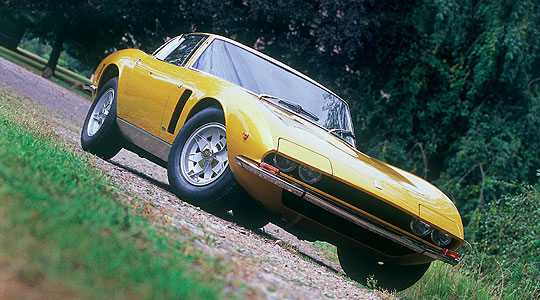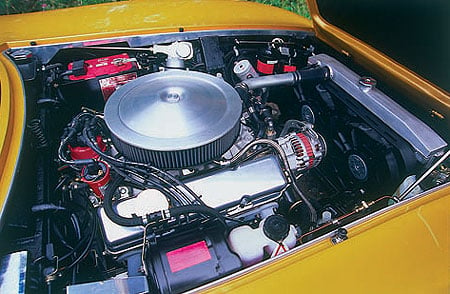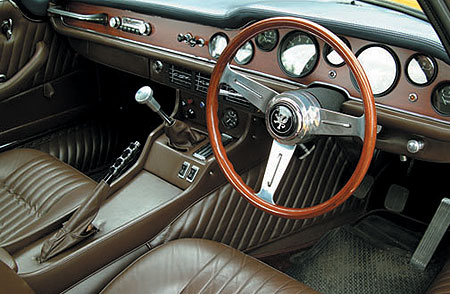
The following is an extract from Tony Dron's feature in Auto Italia magazine, Issue 124 2006. For access to the full feature, plus articles on the Alfa Romeo Brera Q4 V6, Maserati Quattroporte IV, Alfa Romeo exotica such as the Tipo 33 concept cars, a review of the 2006 Le Mans Classic and much more, see www.auto-italia.co.uk
"Not a lot of people know what it is," says Barry Twitchell as we stand admiring his 1971 Grifo. "Most of them think it’s a Ferrari. There was this sharp young bloke who came wandering up at the Brooklands Auto Italia event this year; he looked like a footballer, I thought, and he had this nine out of ten bird in tow who fell in love with the car at first sight.
"They walked round it slowly a couple of times and finally he comes up to me and says, ‘What is it?’ and before I could answer, he says, ‘She loves the style, especially the colour; I’ll give you 90 grand for it. I’ll write a cheque now.’"
Barry was not tempted. Maybe, you might think, he should have torn the man’s arm off but Barry has owned this car since 1976, when he bought it for £2800. In 30 years of ownership he has driven only 2000 miles in it. Instead, he has spent the last 28 years restoring it to utter perfection. He knows exactly what the restoration has cost – getting on for £50,000 – and it seems he’s not in a hurry to part with it at any price.
Back in 1971 this actual car was displayed at the British Motor Show, Earl’s Court. The first Iso Grifo had appeared in 1963 but this model, eight years down the line, was the new-look IR8 with a restyled front end, still by Bertone, featuring ‘drop eyelid headlamps’.
Priced from £8750, it was offered with 300bhp or 350bhp engines, a seven-litre option also being available. The sophisticated suspension system was by de Dion axle at the rear, with radius arms and Watt linkage, and double wishbones with an anti-roll bar at the front. Coil springs were used all round. Final drive was via a Salisbury limited-slip differential and the ZF gearbox, new to the Grifo for 1971, was pretty well bullet-proof and a pleasure to use, if slightly ponderous by modern standards.


No one should have been put off by the use of American engines in an Italian supercar. The Chevrolet V8s – a classic in their own right – were not simply taken from crates and bolted into the Grifo. They were rebuilt to a special specification by Iso, strengthening the bottom end and improving the breathing among other modifications.
When Barry spotted this Grifo, it was five years old, with very low mileage. He snapped it up and then realised that, as a used car, it was already in need of fairly serious restoration. The tell-tale signs were there, suggesting that rust was forming deep in the structure. The car became Barry’s long-term project; his very long-term and highly treasured project. The car was stripped and slowly rebuilt over the years, the most painstaking attention going into the restoration or recreation of every individual item.
He started by removing the engine and gearbox. The rolling chassis went to Clive Smart at Bodylines in 1980 for new front and rear valances, a new boot and door skins. With the bare chassis exposed, the predictable rust spots around suspension pick-up points and behind the sills were revealed. The rot was far from catastrophic but it all had to be cut out and freshly fabricated sections welded in. The rebuilt chassis platform was then given the proper protection against future rust which no cars of that age, however exotic and expensive, received when new. Barry sandblasted it himself, then primed it with 769 Rustoleum ready for undercoating.
By about 1990, Barry was working on suspension components and brakes, sandblasting, priming or applying powdercoat as necessary. Meanwhile, Parts and Panels fabricated a new boot floor and many other items, including a new bonnet with cooling louvres and a new aluminium fuel tank with details to Barry’s own design.
While the car was still a bare body shell, he discovered that the original door-sealing rubbers were unobtainable. He therefore reduced the door aperture flanges very slightly so that modern push-on rubber sections could be used. "Much fettling and filing was needed to get the doors to fit correctly. It took me about six weeks." And when it came to the brightwork and other body details, Barry made many of the parts himself from scratch.
Adrian George at Spraytec did the bare-metal respray after much research into the specification for the correct original Champagne Cocktail finish. Final assembly – as he fondly thought! – began in 2000 but endless small problems still had to be sorted out. "Fitting up the electric window mechanisms alone took an absolute age," says Barry, "about one week or so per door, having to shim it all up to work correctly."
Towards the end the engine came back from Real Steel. It had been rebuilt to a higher specification, including a forged steel crank, special con-rods and pistons. With the rebuilt gearbox and back axle, the whole car finally came together. In March this year, out it came and all I can say is that it’s the best Grifo I have ever seen, or am ever likely to see.
|
Words by Tony Dron and pictures courtesy of Michael Ward.
See www.auto-italia.co.uk or call +44(0)1858 438817 for back issues and subscriptions. |
ClassicInside - The Classic Driver Newsletter
Free Subscription!




